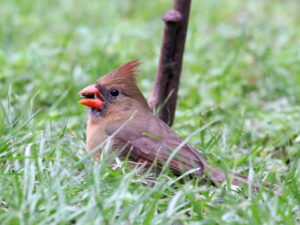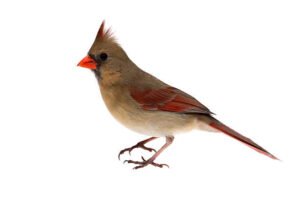What is the Size and Shape of the Female Cardinal
The Dimensions and Form of the Female Cardinal

The female cardinal, scientifically known as Cardinalis, is a species of songbird native to North America, renowned for its vibrant plumage and melodic vocalizations. While much attention has been devoted to its male counterpart, the female cardinal possesses equally fascinating characteristics that warrant exploration. In this comprehensive examination, we delve into the intricacies of the size and shape of the female cardinal, shedding light on the distinctive features that distinguish this avian species.
The female cardinal exhibits a subtle yet captivating color palette, characterized by a blend of warm earth tones, including shades of brown, olive, and muted red. These hues serve a dual purpose, providing effective camouflage amidst foliage while maintaining an aesthetic appeal. Unlike the flashy scarlet hue of the male cardinal, the female plumage is a testament to the evolutionary adaptations that optimize survival in diverse habitats.
Size is another noteworthy aspect of the female cardinal’s anatomy. While generally smaller than their male counterparts, female cardinals display remarkable agility and resilience essential in nesting, foraging, and protecting their territory. Exploring the factors contributing to their size and its implications on their behavior and ecological niche unveils a captivating narrative of adaptation and survival strategies.
Understanding the size and shape of the female cardinal extends beyond mere biological dimensions. It opens a window into the broader ecological context, revealing the intricate interplay between form and function in the avian world. As we embark on this exploration, we aim to unravel the mysteries surrounding the female cardinal’s physical attributes, fostering a deeper appreciation for the diversity and complexity of the natural world.
Size and Shape of Female Cardinal Body
The size and shape of the female cardinal’s body are critical elements that contribute to its overall physiology and functionality. When examining these aspects, it is essential to consider how they align with the bird’s ecological niche, reproductive behaviors, and survival strategies.

Like many bird species, the female cardinal displays sexual dimorphism, where males and females exhibit differences in size and appearance. In the case of the female cardinal, she is generally slightly smaller than her male counterpart. This size difference is not merely a matter of aesthetics; it is intricately linked to the roles each gender plays in the species’ life.
In terms of size, the female cardinal typically measures around 8 to 9 inches in length and has a wingspan ranging from 9 to 12 inches. This modest size is well-suited for the demands of its lifestyle, allowing the female to navigate through the dense vegetation of its habitat with agility and efficiency. It also plays a crucial role in energy conservation, as smaller bodies generally require less sustenance than larger ones.
Examining the shape of the female cardinal’s body unveils adaptations tailored to its ecological niche. The body is streamlined and well-suited for swift, agile movements, aiding in foraging for food, navigating through vegetation, and avoiding predators. The beak, a prominent feature, is conical and slightly curved, facilitating the consumption of a varied diet that includes seeds, fruits, and insects.
Beyond their aesthetic appeal, Feathers play a pivotal role in the size and shape dynamics of the female cardinal. The plumage is an essential aspect of the bird’s identity and a key element in mate selection, but it also contributes to its thermoregulation and protection. The arrangement of feathers allows for efficient flight, and the coloration, while more subdued than that of the male, provides effective camouflage during nesting and while foraging.
The demands of reproduction further shape the size and shape of the female cardinal’s body. The female’s body undergoes physiological changes as the primary caregiver during nesting. The development of a brood patch, an area of bare skin with increased blood flow, aids in efficient heat transfer to eggs during incubation. This adaptation is a testament to the intricate link between form and function in the evolutionary journey of the female cardinal.
The size and shape of the female cardinal’s body are finely tuned to the requirements of its environment, reproductive duties, and overall survival. The modest size allows for nimble movements, efficient foraging, and energy conservation. The streamlined shape and specialized features like the beak and feathers speak to the bird’s adaptation to its ecological niche. The intricacies of the female cardinal’s body size and shape offer a compelling glimpse into the evolutionary processes that have shaped this remarkable species.
Size and Shape of Female Cardinal Head
The size and shape of the female cardinal’s head are integral components of its anatomy, each contributing to the bird’s sensory perception, communication, and overall survival in its habitat. As we delve into the intricacies of the female cardinal’s head, we uncover a fascinating interplay between form and function.

One of the defining features of the female cardinal’s head is its crest. While not as prominently developed as the male’s vibrant crest, the female possesses a more subdued version. This crest serves both functional and communicative purposes. It can be raised or lowered, indicating the bird’s emotional state or intention. During courtship or when alarmed, the crest becomes a visual signal, aiding communication with other nearby cardinals.
Examining the size of the female cardinal’s head about its body reveals a balanced proportion, contributing to the bird’s overall aerodynamics and agility. The head houses crucial sensory organs, including the eyes and the beak. The eyes on either side of the head provide a wide field of view, essential for detecting potential threats or opportunities in the surrounding environment. This binocular vision aids depth perception, assisting the female cardinal in foraging and navigating through dense vegetation.
The beak, a prominent feature of the female cardinal’s head, is a versatile tool adapted to its omnivorous diet. It is conical and slightly curved, allowing the bird to efficiently crack open seeds, grasp insects, and pluck fruits. This adaptive beak structure aligns with the bird’s foraging behavior, emphasizing the importance of form meeting function in the evolutionary design of the female cardinal.
Feathers on the head, while contributing to the bird’s overall appearance, also serve practical purposes. They provide insulation and protection and aid in thermoregulation. The coloration of the head feathers is generally more subdued than the rest of the body, offering a degree of camouflage during nesting or while engaged in activities that require a lower profile.
The size and shape of the female cardinal’s head are intricately linked to its vocalization capabilities. While less prolific singers than their male counterparts, female cardinals produce various vocalizations. The syrinx, a unique avian vocal organ located at the base of the trachea, allows for the production of complex sounds. The size and structure of the head play a role in modulating these vocalizations, contributing to the communication repertoire of the female cardinal within its social and environmental context.
The size and shape of the female cardinal’s head are multifaceted adaptations that enhance its survival and reproductive success. From the functional aspects of the crest for communication to the well-adapted beak for feeding, every feature serves a purpose in the bird’s ecology. The balanced proportion of the head to the body, sensory organs, and vocalization capabilities paints a comprehensive picture of how evolution has sculpted this remarkable species to thrive in its North American habitat.
Size and Shape of Female Cardinal Legs
The size and shape of the female cardinal’s legs are crucial in its overall physiology, behavior, and environmental adaptation. While often overshadowed by the bird’s vibrant plumage and distinctive features, the legs are essential components that contribute to the female cardinal’s survival strategies, reproductive activities, and daily functioning.

The legs of the female cardinal are relatively small and slender in proportion to its body size. This adaptation is a reflection of the bird’s predominantly arboreal lifestyle. Cardinals are perching birds, and their legs are well-suited for gripping branches and navigating through the intricate foliage structure. The arrangement of scales on the legs provides additional traction, enhancing their ability to perch securely.
One notable characteristic of the female cardinal’s legs is their coloration. The legs typically have a pale to mid-brown hue, blending with the overall earthy tones of the bird’s plumage. This subtle coloration serves a dual purpose. Firstly, it provides a degree of camouflage, particularly when the female is nesting or foraging on the ground. Secondly, it complements the overall aesthetic of the bird, contributing to its visual harmony.
The structure of the legs is adapted to the cardinal’s perching behavior. The toes are arranged in an anisodactyl pattern, with three toes pointing forward and one backward. This configuration is a common adaptation among perching birds, offering stability and a secure grip on various surfaces. The claws at the end of each toe are sharp and curved, aiding in grasping branches and facilitating the bird’s movements.
The length of the legs is another critical factor in the female cardinal’s lifestyle. While not exceptionally long, the legs provide sufficient reach for the bird to engage in activities such as reaching for seeds or navigating through vegetation. The length balances the demands of perching, walking, and foraging, showcasing the efficiency of evolutionary adaptations. During breeding, the female cardinal’s legs become instrumental in nest-building and caring for the eggs and chicks. The ability to perch securely is crucial when constructing a nest in the branches of shrubs or trees. Additionally, the female uses her legs to rotate and position the eggs during incubation, ensuring optimal heat distribution for the developing embryos.
Understanding the size and shape of the female cardinal’s legs extends beyond mere anatomy. It offers insights into the bird’s ecological niche, its strategies for survival, and the intricate dance between form and function in the natural world. Whether gripping a branch, perching on a feeder, or navigating through dense vegetation, the legs of the female cardinal are a testament to the evolutionary processes that have shaped this iconic North American songbird.
Size and Shape of Female Cardinal Wings
The size and shape of the female cardinal’s wings are integral components of its anatomy, shaping its ability to navigate the aerial environment, forage for food, and engage in essential behaviors crucial for its survival. As we explore the intricacies of the wings, we gain a deeper understanding of the female cardinal’s adaptations to its habitat and the evolutionary forces that have molded this remarkable avian species.

Like their male counterparts, female cardinals are characterized by moderately sized wings adapted for agile flight. The wingspan of the female cardinal typically ranges from 9 to 12 inches, providing a balance between maneuverability and efficiency during flight. This moderate wingspan allows the bird to easily navigate through dense vegetation and woodland areas, where it primarily resides.
The shape of the wings contributes significantly to the female cardinal’s flight capabilities. Cardinals are classified as passerines or perching birds, and their wings are adapted for short bursts of flight rather than sustained soaring. The rounded and relatively short wings allow quick take-offs and precise landings on branches. This design is well-suited for the bird’s lifestyle, where rapid movements between perches and foraging sites are essential.
Feather structure plays a crucial role in the size and shape dynamics of the female cardinal’s wings. The primary flight feathers, located at the outer edges of the wings, are sturdy and provide the necessary lift during flight. The arrangement of these feathers and the overall wing shape contribute to the bird’s ability to generate lift and control its direction in flight. Additionally, the secondary feathers help maintain stability and balance.
The female cardinal’s wings are not only instruments of flight but also tools for communication and territorial displays. During courtship and interactions with other cardinals, both males and females engage in a behavior known as wing flicking. This involves a rapid opening and closing of the wings, creating a visual signal that conveys various messages, from courtship intentions to territorial boundaries.
While the primary function of the wings is flight, they also play a crucial role during foraging activities. Like their male counterparts, female cardinals are omnivorous and feed on a varied diet that includes seeds, fruits, and insects. The efficient design of their wings facilitates the ability to move between different foraging sites quickly.
During the breeding season, the wings become instrumental in another aspect of the female cardinal’s life – nest building. While the male is known to provide materials for nest construction, the female uses her wings to arrange and weave these materials into a sturdy nest. The agility and precision of wing movements are crucial during this process, ensuring the structural integrity of the nest.
The size and shape of the female cardinal’s wings are masterfully adapted to its arboreal lifestyle, emphasizing agility, precision, and efficiency. From navigating dense vegetation to engaging in courtship displays and constructing nests, the wings serve as versatile tools for various aspects of the bird’s life. The evolution of these wing adaptations highlights the intricate balance between the demands of flight, communication, and survival in the dynamic ecosystems that the female cardinal calls home.
Conclusion
The female cardinal, with its intricately designed body, head, legs, and wings, exemplifies the remarkable adaptations shaped by evolution to thrive in its North American habitat. Its body’s modest size and streamlined shape enhance agility, while the subtle coloration contributes to camouflage and aesthetic harmony. The head, adorned with a crest and housing essential sensory organs, serves as a communication hub, allowing the female cardinal to navigate its surroundings precisely.
The legs, slender and well-suited for perching, showcase the bird’s arboreal lifestyle and play a crucial role in nesting and foraging. Meanwhile, the wings, with a moderate span and efficient feather structure, provide the means for swift, controlled flight and facilitate various behaviors, from foraging to courtship displays. Collectively, these adaptations underscore the female cardinal’s ability to navigate the complex ecological challenges of its environment, offering a testament to the intricate interplay between form and function in the natural world.





